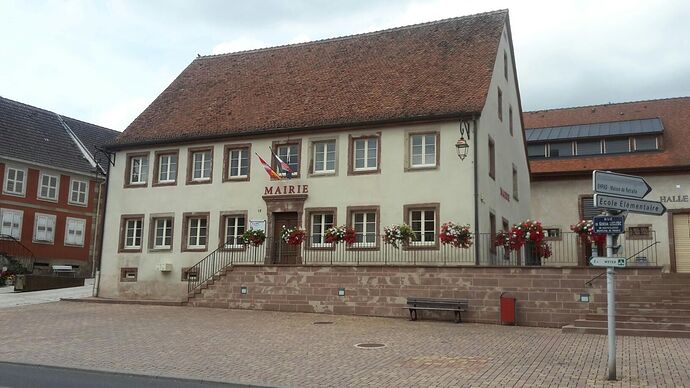Actually there have been long (and mostly inconclusive) debates on a symmetrical topic on the French-speaking forum, about city halls: should they bear no name at all, or “mairie”, or “mairie de Charleville-Mézières”. There is a consensus against “mairie de Charleville Mézières” as far as I recall, but not on the reasons for that.
I don’t know whether the ones I’ve seen and photographed - most times in the neighbouring departement Moselle - are representative. The name on the building is nearly on every photo “Mairie” or “Mairie-Ecole” like this one:
Way: Mairie de Drulingen (44510888) | OpenStreetMap is mapped against this consensus ![]()
Typically, signboards inside buildings are never representative.
The nature of the feature is so obvious on the signboard that it doesn’t need to be revealed.
As another example, we don’t attach descriptors to destination names in tickets to explain the nature of the feature, and we don’t need to.
(e.g. ‘-station’ in a train ticket, ‘-bus stop’ or ‘-bus terminal’ in a bus ticket)
I think the name on the signboard outside the building is more representative.
I think it’s like when my family calls me by my name at home, they don’t bother to include my last name.
But my representative name should still be seen as a name that includes both my first and last name.
This discussion is about the source of the custom and its impact, and we think it’s reasonable to apply the same principle to the names of other features, if only for the reasonableness of the data processing.
Because of cultural and linguistic differences in customs, “attempt to achieve some kind of order” is actually confusing in other cultures, and that’s what prompted me to ask the question.
I don’t know if “Otta” station in the town of “Otta” and “Otta” river in the village of “Otta” is at all strange in some cultures, but at least in my culture, we don’t omit “-station” or “-river” even when it’s not confusing at all.
I don’t think this is just to rant, but to find the reasons and rationale behind it, and to explain how something that is okay to omit in one culture can be confusing in another.
Yes, I’ve come to the conclusion that in my culture it makes more sense not to omit descriptive terms from the names of map features, but many people are still confused by the inconsistency with other cultures’ practices, and I’m trying to rationalize it.
The main topic of this discussion is why certain cultures and languages often omit descriptive terms, but I’d like to add that there are other resources that can help you see customs and trends across cultures.
Telegram user ‘tan sam’ sent me a very valuable resource. - ‘Railway station’ at Wikimedia Commons.
It’s a collection of images of train stations from wikimedia, and you can see that in the West, at least, the descriptive term “-station” is often omitted, even on exterior signboards, whereas in East Asia in particular, the descriptive term tends to be mandatory.
For those who are catching up on this thread, let me summarize my understanding of the original question.
OSM, as well as Google Maps, often omits the descriptive term from the name of a place, which is rare in East Asia, at least in Korea, and has often caused confusion when writing down the name of a place.
That’s why I posted a question about why some cultures omit the descriptive term, which is also written on the signboard outside of the place.
I realized that even in those “some cultures,” descriptive terms are sometimes common and sometimes not, depending on the language.
Eventually, I realized that for people in those “some cultures”, descriptive terms are perceived as an extra element that is not part of the name of an object.
For those of you in those ‘some cultures’, in my part of the world, East Asia, the descriptor is considered part of the name of the object.
For example, if the city of Seoul in South Korea has “Seoul Station” and “Seoul River” and “Seoul Bridge”, the descriptive term “-city” can only be omitted from the name of the city that represents all of them, and never from the names of the rest of the features.
We never omit a descriptive term from a name of a thing that cannot represent it, even if there is no other thing with the same name and there is no way to get confused. (In other words, we don’t refer to “OO Station” as “OO” even if there is no other name for it.)
In other words, only city names that represent the name ‘Seoul’ can omit the descriptive term; if someone says ‘Seoul’ without any descriptive term, they are referring to the name of the city, the name of the region, the name of everything. (Of course, it’s the same as in other cultures, where it’s very clear what it’s referring to, so it’s not necessary to include a descriptor on signs, tickets, etc. because it’s so obvious.)
So when you see place names like “OO Station” or “OO River” in East Asia, especially in Korea, please understand that this is a common practice in that culture.
Conversely, if you see completely different features in some other cultures all labeled “OO” with no descriptive term, don’t get confused and try to determine what properties they have.
It was a bit of a learning curve, but I realized that we express things differently for ridiculously simple reasons, and it was a pretty good discussion about understanding other cultures.
Thanks to everyone who contributed to this discussion.
Addendum: Nevertheless, the reason or rationale for omitting descriptive terms in maps such as OSM is unclear, especially for station names.
